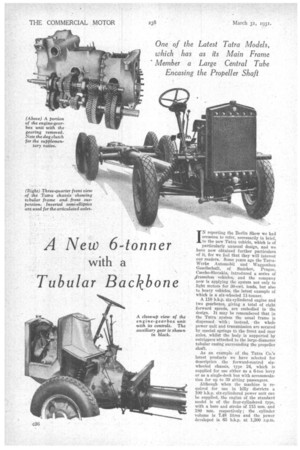A New 6-tonner
Page 58

Page 59

If you've noticed an error in this article please click here to report it so we can fix it.
with a
Tubular Backbone
IN reporting the Berlin Show we had occasion to refer, necessarily in brief, to the new Tatra vehicle, which is of particularly unusual design, and we have now obtained further particulars of it, for we feel that they will interest our readers. Some years ago the TatraWerke Autornobil und Waggonbau Gesellschaft, of Stnichov, Prague, Csecho-Slovakia, introduced a series of 'frameless vehicles, and the company now is applying the system not only to light motors for 30-cwt. loads, but also to heavy vehicles, the latest example of which is a six-wheeled 11-tonner.
A. 110 b.h.p. Six-cylindered engine and two gearboxes, giving a total of eight forward speeds, are embodied in the design. It may be remembered that in the Tatra system the usual frame is dispensed with ; instead, the whole power unit and transmission are secured by special springs to the front and rear axles, whilst the body is supported by outriggers attached to the large-diameter tubular casing surrounding the propeller shaft. .
As an example of the Tatra Co.'s latest products we have selected for description the forward-control sixwheeled chassis, type 24, which is supplied for use either as a 6-ton lorry or as a single-deck bus with accommodation for up to 39 sitting passengers.
Although when the machine is required for use in hilly districts a 100 b.h.p. six-cylindered power unit can be supplied, the engine of the standard model is of the four-cylindered type, with a bore and stroke of 115 min. and 180 mm. respectively ; the cylinder volume is 7.48 litres and the power developed is 65 b.h.p. at 1,200 r.pm. Tha four cylinders, which are cast en bloc, have detachable heads removable in pairs.
The camshaft gearing, contrary to the usual practice, is located at the flywheel end of the engine. The . valves are of the overhead pattern, operated by means of rocker levers and vertical rods from a camshaft located in the crankcase. The crankshaft is supported on three large ball bearings.
The radiator is built up of six interchangeable units, arranged so that in case of damage they can be readily replaced. Ignition is by magneto.
The power from the four-speed-andreverse gearbox is transmitted to the rear axles by a long, enclosed propeller shaft without universal joints. A feature of the final drive is that, whilst two sets of differential gears are pro vided, there are OD the rear end of the propeller shaft and its extension four bevel pinions meshing with their respective bevel crown wheels—one for each of the four live shafts. In'this arrangement there are, it will be seen, two sets of bevel gears for each axle, it being claimed that each live shaft or half axle, with its corresponding road wheel, is able to adjust itself to the angle of the ground when the vehicle is travelling over rough country. Means are also provided for locking the differential
gear. The two rear-axle casings are secured to the ends of centrally pivoted inverted semi-elliptic springs.
Another feature of the vehicle is the front axle, which is set back to the rear of the engine. The axle is built up in two portions, so that the front wheels can rise and fall independently without any strain being imposed on the power unit or central tubular member, each half axle being secured to the gearbox by means of special spiral springs.
As regards the brakes these also are somewhat unusual. Each of the four rear, road wheels is provided with a pedal-actuated servo brake, arranged so that should any defect arise in the servo mechanism, the-pedal can still mechanically apply the brakes. A second pedal operates a brake working on a. drum at the extended rear end of the propeller shaft. Finally, an emergency lever works brakes on the four -back wheels.
The' Tatra Co: is closely following developments in connection with coat: pression-ignition engines, and is, we learn, at present carrying out experiments with an 80 b.h.p. six-eylindered engine built on the Acre-Bosch system.












































































































